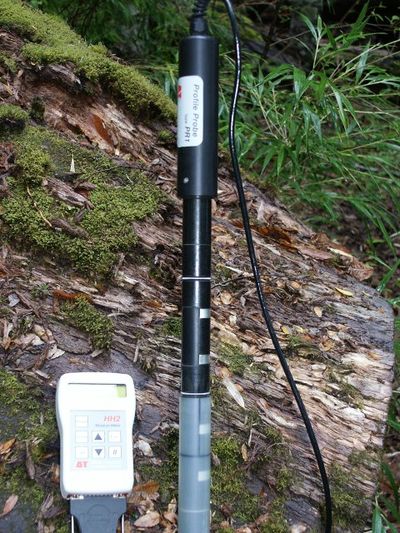Soil moisture - FDR (profile probe)
Jump to navigation
Jump to search
Parameter to be measured:
Soil moisture. Continuous soil moisture monitoring along a soil profile.
Method:
FDR - frequency domain reflectometry, capacitive
Equipment:
- Delta-T Device: Profile probe (PR1/PR2)
Advantages:
- measures soil moisture in 4-6 depths with a maximum depth of 1 m.
- manual as well as continuously logging measurements are possible
Disadvantages:
- Each probe has to be calibrated (however, it does come with a standard calibration for organic and for mineral soil)
- The application of probe in stony soils is very limited
- The soil is always disturbed after installing the pipe. So you have to wait at least a month to get "real" measurements
- Preferential flow along the probe can be initiated, so that the probe measures always wetter states compared to the surrounding media.
- In gravel rich soils installation is complicate.
- There is a temperature affect on the soil moisture signal.
- If probe is placed manually prior to each measurement, it is unlikely to make good contact with the soil, resulting in a dry bias to the measurements.
What to watch out for:
- The access tube for the probe needs to be very carefully installed. There should be no air gap between the access tube and the soil!
- If you have access tubes installed in the field, but are taking only manual measurements from time to time (i.e. the probe is not continuously inside the access tube) make sure to check for condensated water inside the tube before making measurements.
- Test each sensor along the probe by covering one after the other with a wet cloth and taking a measurement, just to see if there is a reaction.
- Look at the data carefully. Test if there is a preferential flow between pipe and soil.
- The inner surface of the pipe has to be kept absolutly dry, otherwise measurement failure can occur.
- When teh analogue version is operated with a DeltaT-logger, it provides teh option to log the values as raw voltage or as soil moisture. When choosing the raw voltage, make sure all the ground terminals of the single sensor rings are connected with a bridge in the logger. Otherwise, strange drifts or noise in all but the signals from ring #1 may occur later in the records.
Problems/Questions:
What is the exact difference between the old version (PR1) and the new version (PR2) of the probe? (see discussion page to this article)
Links
Projects that used the above equipment:
- Identification of runoff processes in a small undisturbed catchment in the Chilean Andes - Experimental study and modelling
- HYGRA: The effect of water storage variations on in-situ gravity measurements and their use
- COMTESS
- Cosmic Sense
Other related web sites:
- Delta-T Devices Eijkelkamp Agrisearch Equipment: User Manual
- Delta-T Devices: User Manual
- Delta-T Devices: Quick start guide
- Delta-T Devices: Augering Manual
References
- Evett, SR., Tolk, JA., Howell, TQ., 2006: Soil profile water content determination: Sensor accuracy, axial response, calibration, temperature dependence, and precision. Vadose Zone 5, 894–907.
- Blume,T., Zehe, E., Bronstert, A., 2009: Use of soil moisture dynamics and patterns at different spatio-temporal scales for the investigation of subsurface flow processes. Hydrol. Earth Syst. Sci., 13, 1215–1234.
